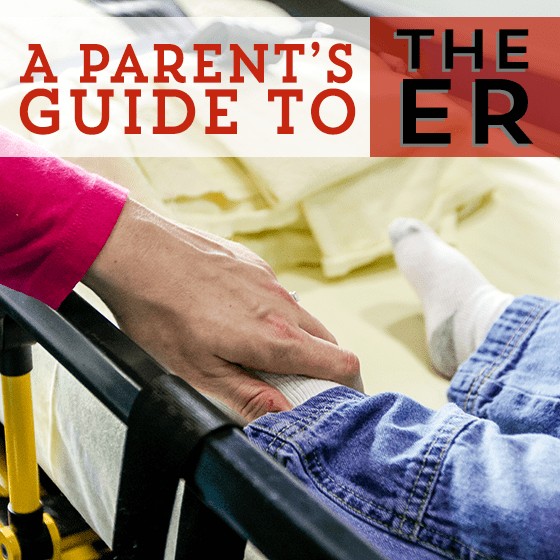Having a sick child can be a frightening thing for parents. Your child’s pediatrician can handle most minor illnesses and injuries. We all know that Emergency Departments are made to handle things like major traumas, obviously broken bones, heart attacks, strokes, seizures, difficulty breathing and other very serious injuries and illnesses. There may come a time, however, when a parent may wonder “is this an emergency?”
When to Take Kids to the ER
Tummy Troubles
Abdominal pain, Vomiting and Diarrhea:
Abdominal pain is a common complaint in children and can also be one of the hardest to assess. Kids can have a hard time describing exactly what they are feeling and where. Some common causes can include gas, constipation, colic in infants, food allergies and viral illness. This is one area that really depends on the observations of the parents. A belly ache that seems “out of the ordinary” or doesn’t seem to go away on its own should prompt a call to your pediatrician [1].
When to Worry:
Abdominal pain that seems to be generally in the right lower part of the belly or around the belly button, is worse with walking, jumping, pressing on it and is accompanied by a low grade fever, vomiting or diarrhea or a swollen distended belly in infants could be caused by appendicitis, which requires prompt medical attention [2].
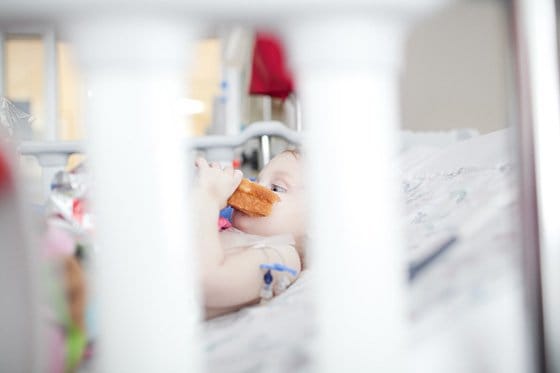
One of the most serious causes of belly pain in infants, especially from around 5-10 months old and especially in boys, is called intussusception, or a condition where one piece of bowel or intestine gets sucked into itself, like a collapsing telescope. Intussusception looks like an intense belly pain where baby pulls his knees up to his chest, cries uncontrollably and has a large distended belly. The hallmark sign of intussusception is bloody, mucousy stool or poop. These babies usually appear (and can become) very sick and are certainly in a lot of pain. Some intussusception can be corrected by a special kind of enema, but others will require surgery. This condition is very distressing to both baby and parents and certainly warrants emergency medical attention [3].
Diarrhea, or liquid stools that are very frequent, is usually caused by a virus which will resolve on its own. It can sometimes cause a reddened rash on the buttocks. Diarrhea can often be managed at home under the cautious eyes of parents or caretakers.
When to Worry:
The main concern regarding diarrhea is dehydration. The proper balance of fluids and salts, or electrolytes, in your baby or child’s blood is necessary for good body function. If your baby or child has lost 5% or more of his or her body weight, appears lethargic, has sunken eyes or a sunken fontanelle in infants, has a dry mouth or lips, is crying but not producing tears, has dry, pale or wrinkled skin, or is urinating infrequently or has dark yellow urine, he or she may benefit from emergency medical care and IV fluids (a mix of fluids and electrolytes given through a small plastic tube inserted in a vein) [4].
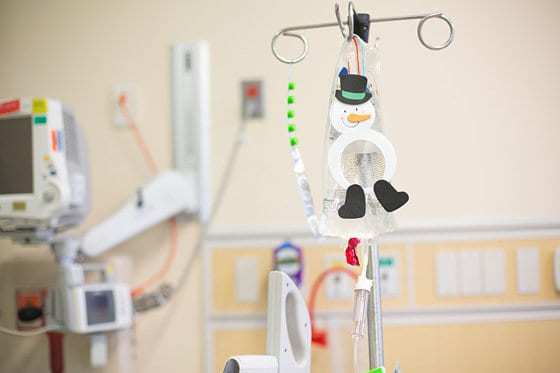
Vomiting can be very distressing to a child and parents, and can certainly make quite a mess! Luckily, vomiting, like diarrhea, is frequently caused by a viral illness or eating spoiled food. In the first few months, infants frequently spit-up very small amounts of whatever they’ve just eaten and this is usually benign and will resolve as baby grows.
When to Worry:
As with diarrhea, a major concern for a vomiting child is dehydration. Measures can be taken at home to try to prevent dehydration, but if your child presents with any of the above listed symptoms, he or she may benefit from IV fluids.
In the first few months, the most serious cause of vomiting is called pyloric stenosis. This happens when the bottom of the stomach becomes narrow and closes up, giving breast milk or formula no place to go, and causes it to come right back up the esophagus and out the mouth. Babies with pyloric stenosis have progressively worse projectile vomiting and are hungry immediately after vomiting. Projectile vomiting is often described as “something you’ve never seen before” and anyone who has seen it will never forget. Whatever baby ate may spray up to 2′, literally hitting the wall next to or behind you. Baby will also have a swollen belly right after eating which goes away after vomiting. The treatment for pyloric stenosis is rehydration with IV fluids and then surgery to reopen the closed off part of the stomach, thus requiring prompt medical treatment and admission to the hospital [5].
Fever
Fever can be a scary thing for parents, but the majority of the time can be managed at home with either over the counter medications like acetaminophen or ibuprofen, or natural methods like removing extra clothing, lukewarm baths and providing plenty of cool liquids to drink.
Normal body temperature can vary from 97* to 100*F depending on what method is used. To learn more about how to take your baby or child’s temperature, read these [6] suggestions from the Mayo Clinic. A low-grade fever is considered to be from 99*F to 100.9*F. Moderate temperatures range from 101*F to 102.9*F, and high temperatures are over 103*F. Fever is a symptom of an underlying illness and is a healthy body’s normal response to infection, and the highest fevers are often caused by viral illnesses that will run their course on their own.
When to Worry:
A rectal temperature of 100.4* or more that lasts longer than eight hours in a child who is 12 weeks or younger should be taken seriously and reported to their pediatrician. If baby seems ill, is lethargic, vomiting, not eating or appears pale, he or she may require emergency medical treatment.
In any baby or child, tiredness that seems to get worse and worse, a pale or ashen color, dull or anxious facial expressions, a baby who still seems sick when the fever has gone, inconsolable crying, or neck pain and stiffness with vomiting could benefit from a visit to the pediatrician’s office and may require an urgent or emergent work up [7].

In some children, especially from ages 6 months to 5 years, the sudden onset of a fever of 100.4*F, or higher, may be announced by a febrile seizure, which looks like a shaking fit, a convulsion, where the whole body shakes in an odd manner, the eyes may roll back and the child may seem to moan. These fits typically last only a few moments to a few minutes and stop on their own with no treatment, and cause no long term damage. When the seizure is over, the child may be confused, agitated or very sleepy. Seizures of any kind can be frightening to parents and especially the first seizure in a child requires an emergent medical assessment, and many parents choose to call for an ambulance.
Coughs and Colds:
Along with fever, coughs and colds are some of the top reasons for calls to the pediatrician. Mainly they are a nuisance and make quite a racket, especially in the middle of the night. Some babies may cough until they vomit. If your baby is coughing, has other cold symptoms, but is eating and playing like she usually does, then the cough can usually be managed at home with no special kind of care or treatment. There are several types of medications and natural remedies on the market to ease baby’s cough and help everyone get some sleep. Cool mist humidifiers and sleeping with the head of the crib mattress slightly elevated may also help.
If baby’s cough is persistent, is associated with fever, tiredness, persists after the other cold symptoms have resolved, or if baby seems to be in pain with coughing, has a severe, deep junky sounding cough that produces green or yellow mucus called “phlegm,” a trip to the pediatrician may be warranted to rule out a pneumonia. Pneumonia is a relatively rare diagnosis in kids, but is easy enough for a pediatrician to distinguish from a common cold [9].
When to Worry:
Croup is a viral infection of the upper airways. It usually comes on in the middle of the night and the cough is described as a bark that sounds like a seal barking. Any health-care worker who has worked with kids for any length of time, especially in winter, can tell a croupy cough from a mile away. The link below has a great video with a soundbite of the classic croup cough:
If baby has this type of cough, but is playing and eating and appears to be acting normally, croup can usually be treated without an urgent visit to the doctor’s office. However, croup can also be quite serious. Babies and young children who cannot take in enough air appear worried, pale, and will not lay down. If you feel like baby is struggling for air, look at the little space on baby’s chest over his breastbone and at his belly. If these areas are caving in with each breath, called retracting, or indrawing in the Dr. Sears book, and he’s making a high pitched raspy sound called stridor, this is a sign that baby needs immediate attention. Sitting in the bathroom with a hot shower running, opening the window to let in cool night air and a calm, loving, reassuring mommy or daddy are some of the best ways to stabilize a crouper. If these measures don’t seem to help, or baby appears more pale, is unable to cry due to lack of breath, he or she will require emergency medical treatment [10].

Whooping cough, or pertussis, is a bacterial infection that starts off like a regular cold, but then progresses to coughing fits that can last 30 seconds to 2 minutes with little opportunity to take a breath, and when the child tries, he or she produces a loud “whooping” sound. It is important to note that only about 50% of people with pertussis “whoop.” The cough can also cause the child to become flushed, drool or cough up a thick mucus or even vomit. Below is a video from the CDC of a child with whooping cough.
Antibiotics can shorten the length of the disease course by approximately five days. Very young babies, 3-6 months or younger, are more likely to get severely ill and require hospitalization with supportive therapy that includes oxygen, intravenous fluids and steroids, suctioning or removal of the thick mucus produced by the cough, and possibly airway support. If you feel your child has whooping cough and you are planning to visit an emergency room, please make an effort to call ahead and notify the staff of your suspicions, as special measures need to be taken to make sure the illness is not passed to anyone else in the department [11].
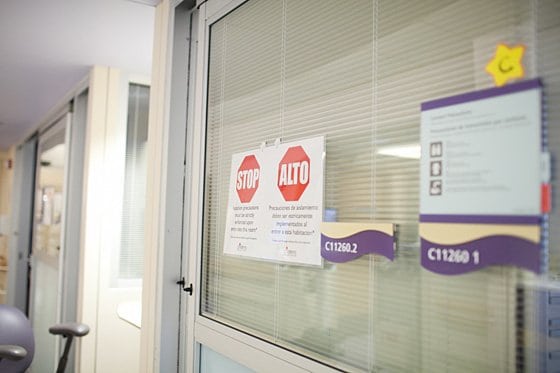
Respiratory Syncytial Virus, or RSV is a common virus that causes cold symptoms. Most everyone is exposed to RSV in the fall and winter months. Very young babies, premature babies, or babies with a disease effecting the heart or lungs can get very sick with RSV. A healthy child or an older child may get RSV, have normal cold symptoms and then recover without anyone ever knowing what the cause was. If you have a premature baby or a baby with medical problems, a cold may be a worsening RSV infection if baby appears sick, has rapid or labored breathing, is producing a lot of thick mucous or has a high fever. If home care methods described by a pediatrician are not working, or if you feel your child is struggling to breathe, he or she may benefit from emergency medical attention [12].
Cuts, Scrapes and Boo-boos:
Every adventurous child will bleed, it’s just a matter of when, from where and how much. No parent ever wants to see their baby hurt, and it can be emotionally overwhelming to see their child’s blood. The best thing a parent can do when their child gets hurt is to stay calm. Most skin injuries can be managed at home with simple first aid.
The first thing to do when your child gets a bleeding injury is to apply direct pressure with a clean cloth or piece of gauze for several minutes; it should be enough time to sing a few of baby’s favorite songs or even tell a story. Try to avoid the squeeze and peek technique (squeeze for a few seconds, let go to peek at the bleeding, then squeeze again) because any boo-boo is almost guaranteed to still be bleeding with anything less than several minutes of continuous direct pressure. After the bleeding has slowed or stopped, hold the injured area under cool running water, wash off the old blood and assess the wound. This may restart the bleeding, which will stop after more pressure is applied. From here you can decide if its a bandaid boo-boo or something that needs a little more. Many scalp wounds, for example, bleed quite a lot initially, but after direct pressure slows or stops the bleeding and the injury is inspected by mom, dad, or a strong-stomached third party, they can turn out to be quite tiny and require no more than a dab of Bacitracin and a few kisses.
When to Worry:
If the wound appears gaping and you can see through all layers of the skin, this wound might need closing by medical professionals. Most people choose to utilize the emergency room for this. Gaping wounds can be closed with adhesive paper or cloth strips, called Steri-strips, conventional stitches, or occasionally a clear wound glue called Dermabond. Which method is used is dependent on the size, depth and location of the cut.

If after several minutes of pressure is applied the wound is still bleeding, or if the bleeding seems disproportionate to the size of the injury, the wound could require emergency medical attention. The concern would be for severed blood vessels. If a vein is cut, the bleeding will flow and the blood will be dark red. Small veins are commonly cut through minor injuries and usually require a little more pressure and potentially some normal stitches. If you decide to visit the emergency room, cover this type of wound with a thick pad of gauze and wrap it snugly with a wrap bandage, but not so tight as you risk cutting circulation off to the lower half of the injured body part. If bleeding comes through the initial bandage, add more gauze on top of it and wrap it again a little more firmly. Applying an ice pack over the injury can help to constrict small blood vessels and slow the bleeding.
If an artery is severed, bright red blood will spurt from the wound. Immediately cover the area and apply firm direct pressure for no less than ten continuous minutes. If you peek, start the timer over. After the ten minutes is up, cover the wound with a dressing as described above for no less than twenty minutes. Remember, if the bleeding comes through the dressing, do not remove the initial wrap and gauze, just add more on top of it. These types of wounds can usually benefit from emergency medical assessment and treatment [13]. If you believe your child has an arterial bleed or is losing a significant amount of blood, consider calling 911.
Having a sick or injured child can be a confusing and even scary thing for parents. Though your pediatrician can handle most things that come up, some basic knowledge and the careful observations on your part can help make the decision of whether or not to go to the ER easier.
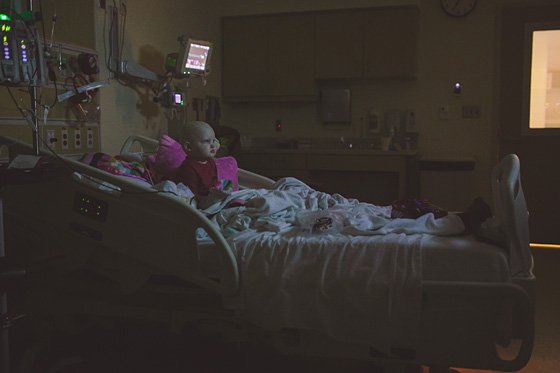
The photos for this post were provided by Amanda with Gingersnap Photographs, whose story can be read at www.thisyearslovewilllast.com
Are you prepared at home in case of an emergency? Check out these helpful posts:
Photo credits: Mother with hand on child adapted from Dana Beveridge (CC BY 2.0). All other photos were provided by Amanda with Gingersnap Photographs, whose story can be read at www.thisyearslovewilllast.com.
References
- Corkins, Dr. Mark, M.D. (2005) “Abdominal Pain in Kids: When to Worry.” Le Bonheur Children’s Hospital Practical Parenting. https://www.lebonheur.org/blogs/safetyblog/entry/abdominal_pain_in_kids_when
- Durani, Dr. Yamini, M.D. (2012) “Appendicitis.” Kids Health from Nemours. https://kidshealth.org/parent/infections/stomach/appendicitis.html#
- Cronan, Dr. Kate, M.D. (2011) “Intussusception.” Kids Health from Nemours.https://kidshealth.org/parent/system/surgical/intussusception.html#
- Sears, Dr. William M.D. Et all. (2013) “Most Common Medical Problems: Self Help Home Care; Diarrhea.” The Baby Book. Pps 685-691.
- Sears, Dr. William M.D. Et all. (2013) “Most Common Medical Problems: Self Help Home Care; Vomiting.” The Baby Book. Pps 691-695.
- Mayo Clinic Staff. (2012) “Thermometer Basics: Taking Your Child’s Temperature.” Healthy Lifestyle; Infant and Toddler Health.https://www.mayoclinic.org/healthy-living/infant-and-toddler-health/in-depth/thermometer/art-20047410?pg=1
- Sears, Dr. William M.D. Et all. (2013) “Most Common Medical Problems: Self Help Home Care; Parenting the Baby with Fever.” The Baby Book. Pps 649-660.
- Durani, Dr. Yamini M.D. (2012) “Febrile Seizures.” Kids Health from Nemours. https://kidshealth.org/parent/general/sick/febrile.html
- Sears, Dr. William M.D. Et all. (2013) “Most Common Medical Problems: Self Help Home Care; Coughs.” The Baby Book. Pps 671-674.
- Sears, Dr. William M.D. Et all. (2013) “Most Common Medical Problems: Self Help Home Care; Croup.” The Baby Book. Pps 683-685.
- Ben-Joseph, Dr, Elana Pearl M.D. (2014) “Whooping Cough (Pertussis).” Kids Health from Nemours https://kidshealth.org/parent/infections/bacterial_viral/whooping_cough.html#
- “RSV: When it’s More Thank Just a Cold.” (2013) Healthy Children Magazine; Winter 2008. https://www.healthychildren.org/English/health-issues/conditions/chest-lungs/Pages/RSV-When-Its-More-Than-Just-a-Cold.aspx
- Sears, Dr. William M.D. Et all. (2013) “Lifesaving Procedures and First Aid for Common Emergencies; Bleeding.” The Baby Book. Pps. 725-726.



































